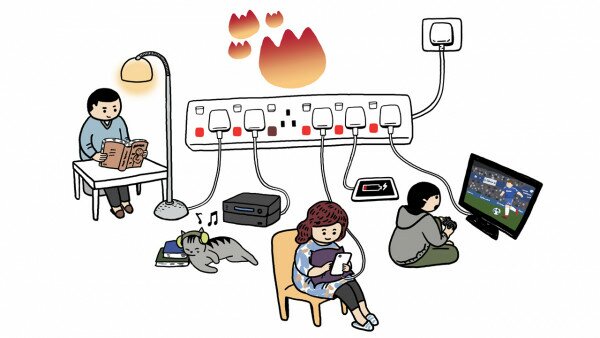Extension units are essential household products to augment insufficient fixed socket outlets. The Consumer Council tested 12 models of extension units each with 6 sockets and individual switches and found that none of the models passed all safety test items. Among which, 3 models had short circuit, switch damage or temperature rise exceeding standard limit and were voluntarily recalled by the concerned suppliers or manufacturers. The remaining 9 models failed to meet parts of the test requirements which concern endurance and other problems.
If the extension unit is substandard, it may pose safety risk at home to the worst situation of fire hazard. Therefore, to uphold the product qualities of extension units and consumers know how to use the products safely is critical. The Council conducted a similar test on the same product type in 2012. Among that 16 models with 4 sockets then tested, 5 models passed all safety tests. In the latest study, based on the same set of standard, the Council found that none of the 12 models could pass all safety test items which the result was worrisome.
All tested models of extension units with 6 sockets had individual switches and were fitted with safety shutters, with prices ranging from $99 to $169. The Council commissioned an independent laboratory to carry out the testing with reference to the British Standard BS1363-2. The tests examined construction of sockets, temperature rise, wiring and cable, endurance of sockets and switches. All models were found to have various safety deficiencies. On a 5-point scale, they were graded between 1.5 and 4.
Construction of sockets in 6 models was inadequate. Some of the pin housing could not retain the "test pin" firmly for 30 consecutive seconds or more in 4 of the models, revealing that the copper contacts in the pin housing were not sufficiently strong. The size of pin housing of the line and neutral pins slightly exceeded the limit in 2 models, although the risk of circuit overload due to poor contact was low. The measured voltage drops between some of the copper contact and corresponding plug pin in 3 models exceeded the limit which may result in overheating.
Construction of sockets of 7 models was found to fall below the standard after 15,000 times of socket endurance test. Short circuit occurred during the endurance test in 1 model and the fuse of the power supply became blown, making it impossible to complete the remaining test items. This model had an overall grade of 1.5 points only and the supplier voluntarily recalled the product. Copper contacts in 3 models were found worn down. User needs to put in extra force to pull plugs out. The measured voltage drops across the copper contact and the corresponding plug pin exceeded the limit was found in 4 models.
All models tested came with individual switches, among which 10 models had switches not in compliance with the standard requirement. 5 models revealed that the measured voltage drops across part of the switched poles exceeded the limit. After switch endurance test, 8 models were found to exceed the limit of voltage drop in part or all the switched poles. On 1 model, after completing the socket endurance test, the plastic part of one of the switches was melted during the temperature rise test.
The test also revealed that in 1 model when 4 sockets were in use, the temperature rise was 76K, above the standard's limit at 52K. The temperature rise of that model was recorded at levels higher than the standard at 63K and 79K respectively, when 1 or 4 sockets were in use following the socket endurance test. This overheating could affect safety of the product.
In other tests, 1 model's insulation distance was found to be slightly below standard. The power cord of 1 model was pulled out during flexing test, reflecting an improper cable anchorage.
Extension unit is one of the frequently-used household products. For safety, consumers should be cautious and take heed of the following tips when using them:
- Avoid using any extension unit in a humid or wet environment (e.g. bathroom);
- To prevent circuit overload, no more than one adaptor or one extension unit should be inserted into a wall socket outlet;
- Switch off unused home appliances via the individual switch on the socket. If the extension unit does not have individual switches, simply unplug the appliances from the socket;
- Heaters and electric irons are high power consumption home appliances, use a fixed socket outlet independently to operate them;
- If overheat or short circuit happens, stop using to avoid safety risk.
The Consumer Council reserves all its right (including copyright) in respect of CHOICE magazine and Online CHOICE.



